2.3 Energy flows through ecosystems, while matter recycles
food web A set of feeding relationships among organisms indicating the flow of energy and materials in an ecosystem.
trophic level A step in the movement of materials or energy through an ecosystem or the position of a species in a food web.
An influx of energy is required to maintain order in ecosystems and to sustain their physical and biological processes. For most ecosystems, the Sun is the primary source of energy. Plants and algae convert this solar energy into chemical energy, which then moves from plant to animal to animal in the form of food. These movements of energy form a web of energy transfers called a food web (Figure 2.9). Food webs show who eats whom in an association of coexisting organisms. One of the basic elements in a food web is the trophic level of each organism, which identifies its position in the overall movement of materials or energy through an ecosystem.
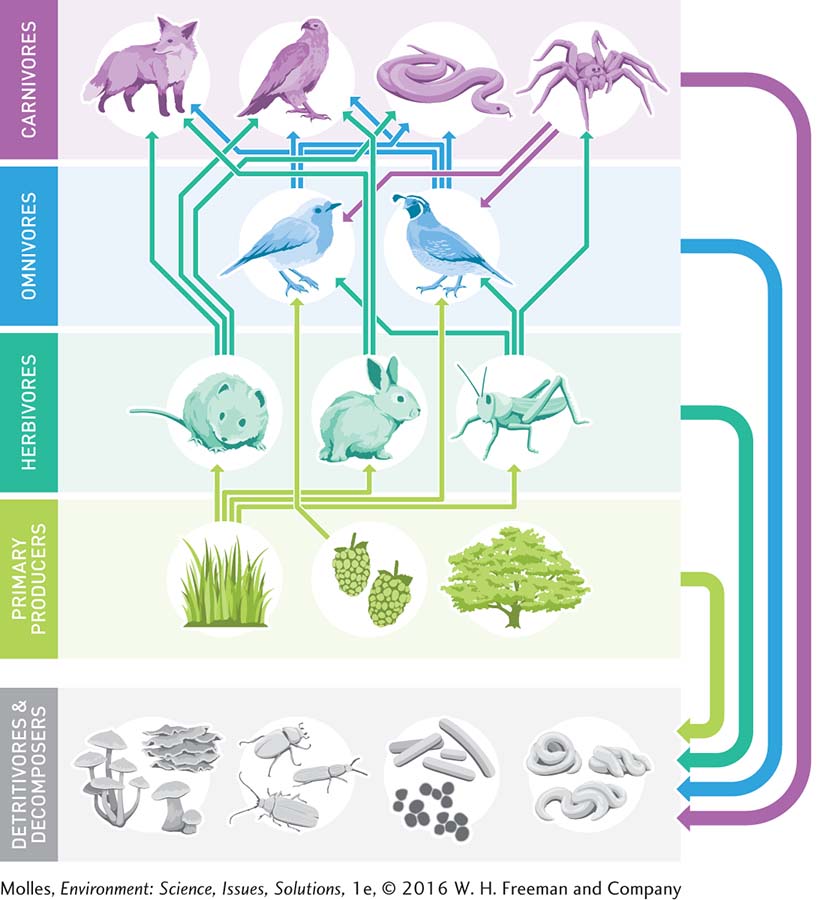
primary producer (autotroph) An organism, generally a plant or alga, that converts the radiant energy in sunlight to the chemical energy in sugars through the process of photosynthesis.
photosynthesis A biochemical process employed by green plants, algae, and some bacteria that uses solar energy to convert water and carbon dioxide into the chemical energy in a simple sugar called glucose.
The primary producers, or autotrophs, always occupy the first, or lowest, level in a food web. Primary producers, mostly plants on land and algae in aquatic ecosystems, produce the materials that form the basis of what all organisms need to stay alive. They do this by means of photosynthesis, a biochemical process that uses solar energy to convert water and carbon dioxide into the chemical energy in a simple sugar called glucose (Figure 2.10).
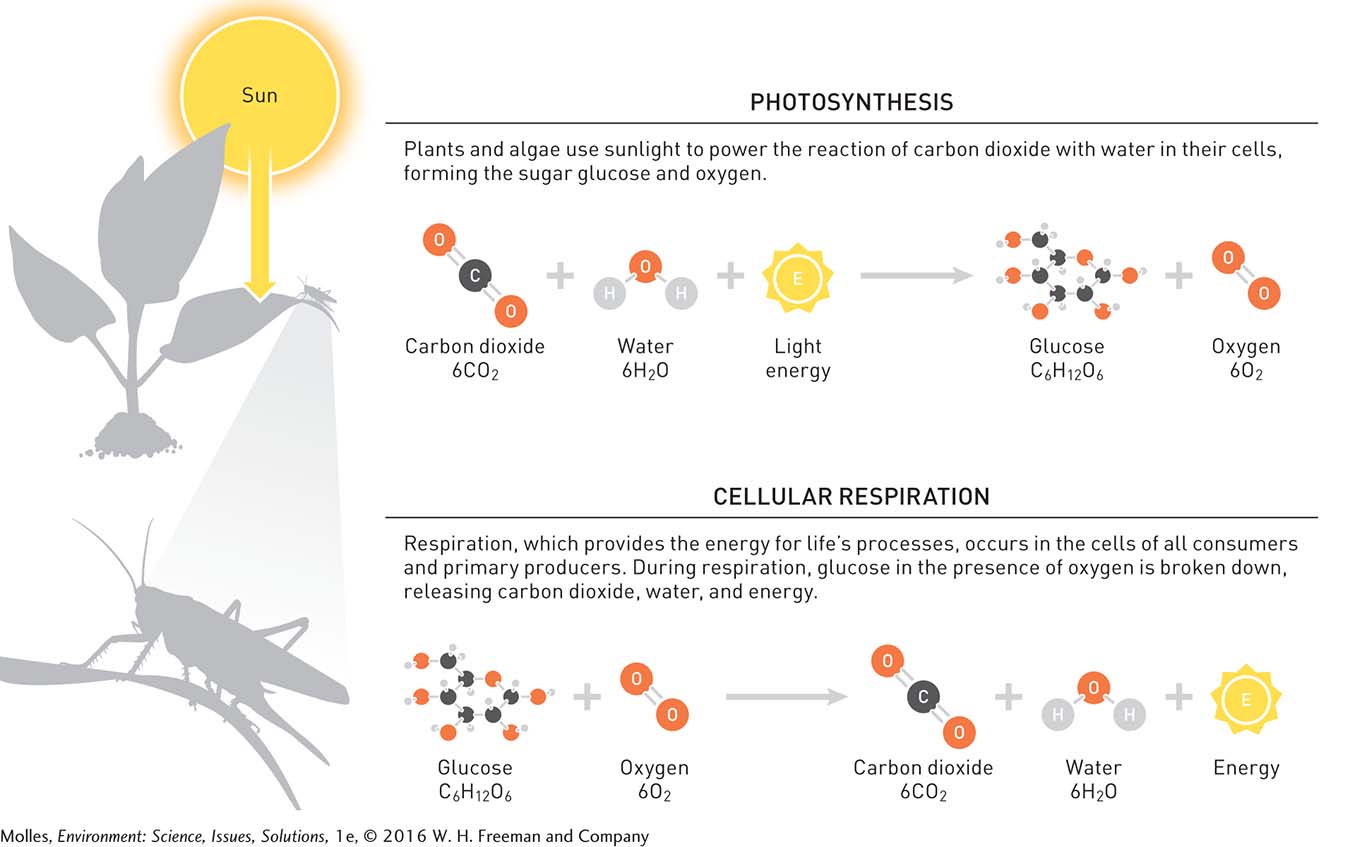
gross primary production
The total amount of organic matter produced by the primary producers in an ecosystem over some period of time, for example, per year. See net primary production.
net primary production
The net production of organic matter by the primary producers in an ecosystem, that is, gross primary production less the organic matter used by primary producers to meet their own energy needs. See gross primary production.
Ecologists refer to the total amount of organic matter produced by the primary producers in an ecosystem over some period of time as gross primary production. However, plants expend energy for all kinds of things besides growth: in respiration; in maintaining the structure of their tissues; and in defending themselves against attack by viruses, bacteria, fungi, insects, and other organisms. The amount of energy left over after subtracting these factors is called net primary production. Net primary production can also be looked at as the amount of food energy available to other organisms that feed on primary producers.
consumer An organism that meets its dietary needs by feeding on other organisms or on organic matter produced by other organisms. See heterotroph.
heterotroph An organism, incapable of producing its own food, that meets its energetic and nutritional needs by feeding on organic matter produced by plants and other primary producers or on other heterotrophs. See consumer.
cellular respiration A process taking place in cells that requires oxygen. During cellular respiration, molecules, such as glucose, are broken down and energy, water, and carbon dioxide are released.
herbivore (primary consumer) A consumer whose diet consists entirely of plants or other primary producers, for instance, an elephant or a grasshopper.
carnivore (predator) An animal that feeds on other living animals (e.g., a lion or a spider).
omnivore A consumer that eats both plant and animal material.
detritivore An organism that feeds on dead organic matter (e.g., fallen leaves on the floor of a forest). Detritivores help in the process of decomposition; examples include many insects and earthworms. See decomposer.
decomposer An organism, mainly fungi and bacteria, that breaks down dead plant and animal tissues, promoting the process of decomposition. See detritivore.
The organisms occupying trophic levels above the producers, which feed on organic matter produced by other organisms, are collectively referred to as consumers, or heterotrophs. Consumers meet their energy needs by extracting the energy from their food through cellular respiration, a process that occurs in the cells of all organisms (Figure 2.10). Consumers that feed on plants are called herbivores or primary consumers, while those feeding on other consumers are called carnivores, predators, or secondary consumers. Some consumers, called omnivores, eat both plants and animals. Finally, a critical group of consumers in any food web are the detritivores, or decomposers. These organisms, which feed on dead and decaying plant and animal material, are particularly important in the cycling of matter in ecosystems.
secondary (consumer) production The amount of consumer biomass, or energy, that goes into growth and reproduction, analogous to net primary production by photosynthetic organisms.
The net amount of consumer biomass, or energy, that goes into growth and reproduction, is referred to as secondary production.
energy pyramid A graphic representation of the distribution of energy among trophic levels in an ecosystem. Because large amounts of energy are dissipated at every trophic level, these diagrams take the form of a pyramid.
As a result of energy losses at each trophic level (thanks to the second law of thermodynamics), a graph of the net production by all the organisms in each trophic level in an ecosystem takes the form of a pyramid, broader at the base, representing net primary production and narrowing progressively at higher trophic levels. Figure 2.11 gives an example of an energy pyramid from the Silver Springs ecosystem in Florida. Because up to 90% of energy is lost between trophic levels, energy makes a one-

Examine Figure 2.11. Explain how this image illustrates both the flow of energy and transfer of materials in an ecosystem?
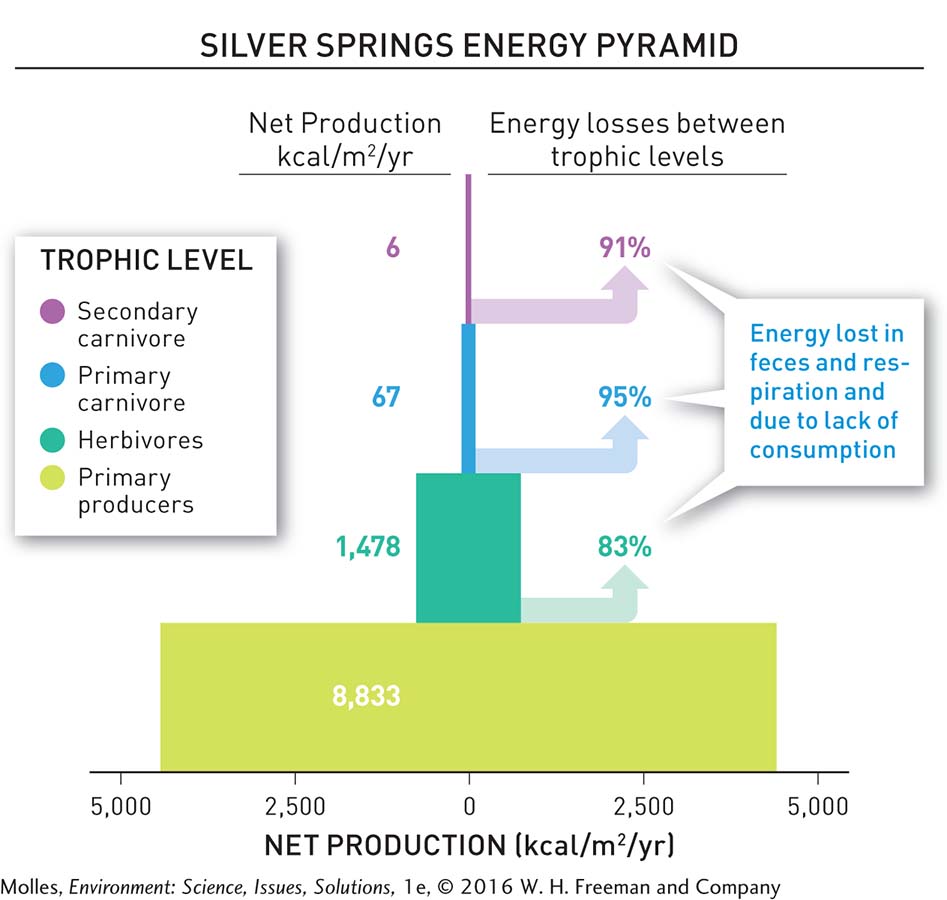
The effects of the second law of thermodynamics on food webs and trophic pyramids have some practical consequences. For instance, carnivores will always be less abundant than their prey species and, consequently, more likely to be in danger of extinction. Also, because of lower production at higher trophic levels, producing enough animal protein for everyone on Earth to have a diet comparable to that in the United States would not be sustainable.
Material Cycling
conservation of matter A physical law describing how during chemical reactions, matter is neither created nor destroyed but conserved.
Matter, like energy, also flows through ecosystems. According to the principle of the conservation of matter, matter is neither created nor destroyed—

Does the conservation of matter mean that the amount of matter in the Earth system is not subject to change?
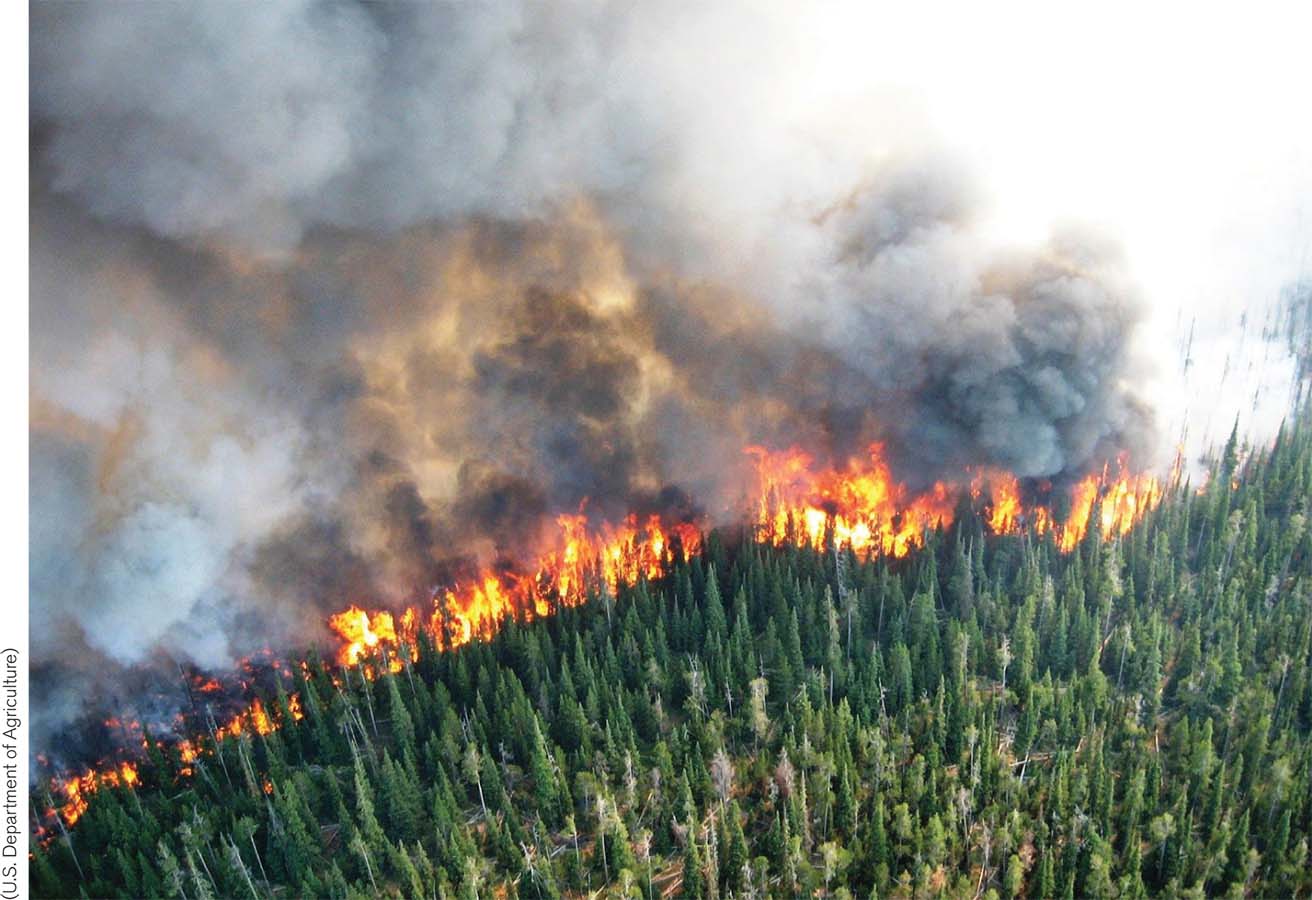
You can demonstrate this fact for yourself by reviewing the chemical equations in Figure 2.10 (see page 40). Count the number of atoms on the two sides of the reactions in Figure 2.10, and you will find that, though the atoms have been rearranged, their numbers are the same.
biogeochemical cycle The cyclic path of an inorganic substance, such as phosphorus, nitrogen, or carbon, through the Earth system, including the atmosphere, Earth’s crust, oceans, lakes, and rivers; key biological components are producers, consumers, detritivores, and decomposer bacteria and fungi.
Examples of substances that get cycled include water, nitrogen, carbon, phosphorus, sulfur, and iron. The cycles of these and other substances are called biogeochemical cycles because they involve biotic, or living components like plants and animals, and abiotic (nonliving) components, including Earth’s water, minerals, and atmosphere. The biological components of biogeochemical cycles include the producers, herbivores, carnivores, detritivores, and decomposer bacteria and fungi represented in Figure 2.9 (see page 40). Decomposition of organic matter releases inorganic substances, such as nitrogen, phosphorus, or carbon, which are returned to soil, atmosphere, or water.
carbon cycle The cycling of carbon through the Earth system; key biological processes in the carbon cycle include photosynthesis, respiration, and decomposition.
One molecule that has been making headlines for years is carbon dioxide, an important part of the global carbon cycle. Carbon plays a central role in the lives of all organisms as most of the molecules essential to the structure and functioning of living cells—
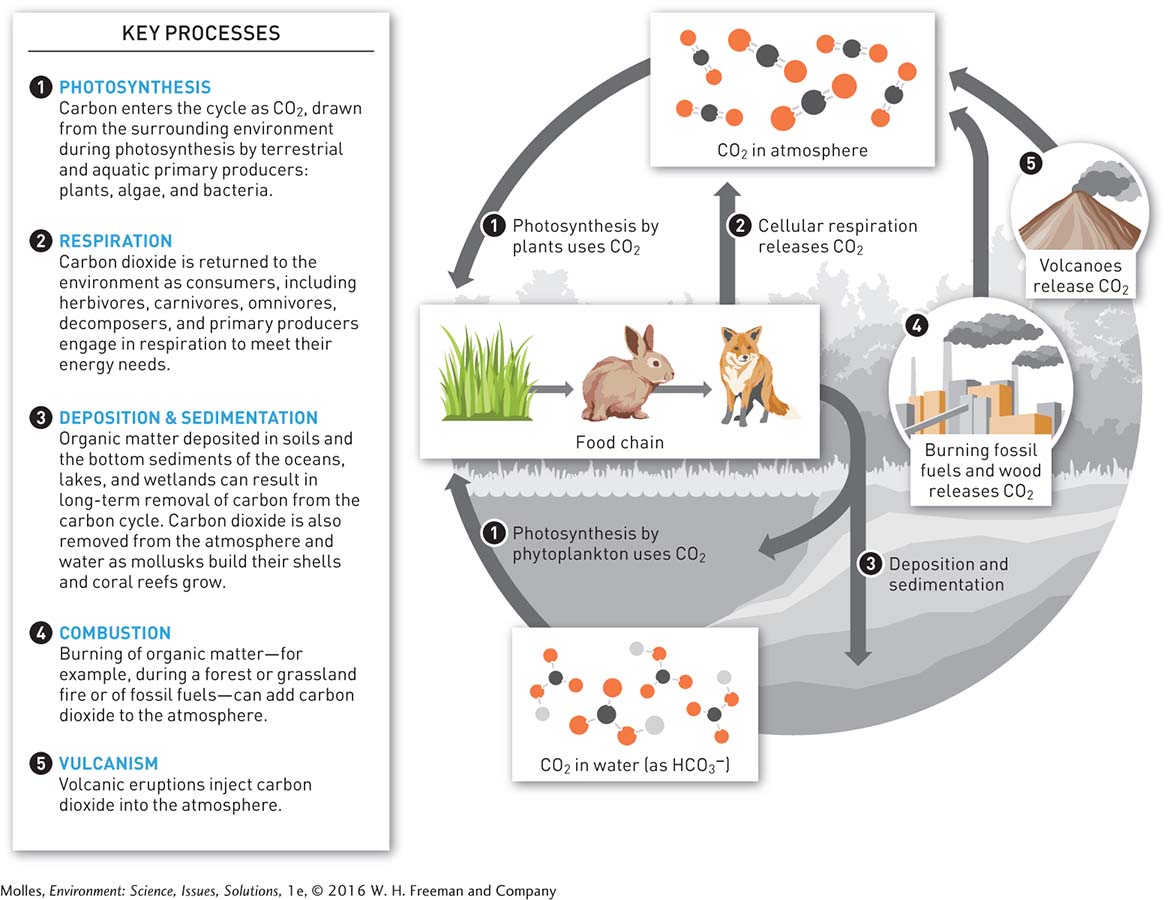
Because matter cannot be created or destroyed, biogeochemical cycles like the carbon cycle move essential elements around Earth continuously. For more on biogeochemical cycles, see Chapter 7 (nitrogen cycle), Chapter 8 (phosphorus cycle), and Chapter 13 (sulfur cycle). Another cycle, the hydrologic, or water, cycle plays a key role in the discussions of water-
Think About It
Why is consumer production also known as secondary production?
How is the second law of thermodynamics related to the fact that net primary production is always less than gross primary production?
How do photosynthesis and respiration contribute to Earth’s carbon cycle?